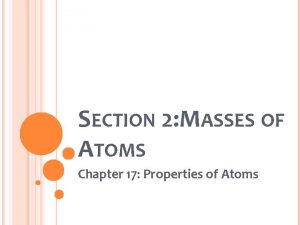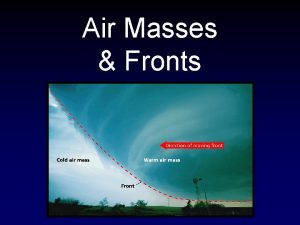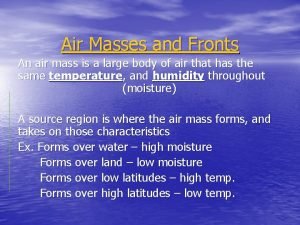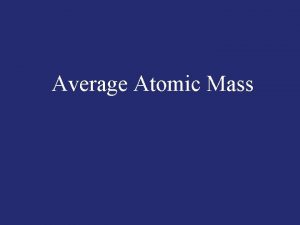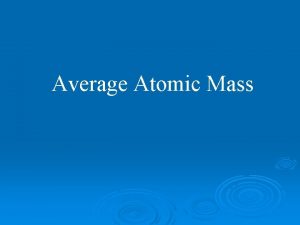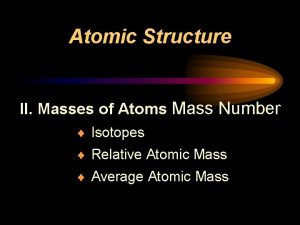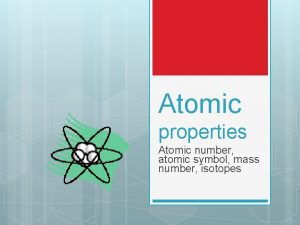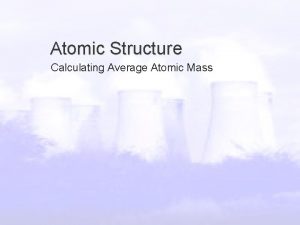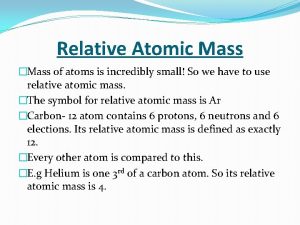Section 2 Masses of Atoms Atomic Mass Section














- Slides: 14

Section 2 Masses of Atoms Atomic Mass

Section 2 Masses of Atoms Atomic Mass • The nucleus contains most of the mass of the atom because protons and neutrons are far more massive than electrons. • The mass of a proton is about the same as that of a neutron.

Section 2 Masses of Atoms Atomic Mass • The mass of each is approximately 1, 800 times greater than the mass of the electron.

Section 2 Masses of Atoms Atomic Mass • The unit of measurement used for atomic particles is the atomic mass unit (amu). • The mass of a proton or a neutron is almost equal to 1 amu. • The atomic mass unit is defined as one-twelfth the mass of a carbon atom containing six protons and six neutrons.

Section 2 Masses of Atoms Atomic Number • The number of protons tells you what type of atom you have and vice versa. For example, every carbon atom has six protons. Also, all atoms with six protons are carbon atoms. • The number of protons in an atom is equal to a number called the atomic number.

Section 2 Masses of Atoms Mass Number • The mass number of an atom is the sum of the number of protons and the number of neutrons in the nucleus of an atom.

Section 2 Masses of Atoms Mass Number • If you know the mass number and the atomic number of an atom, you can calculate the number of neutrons = mass number – atomic number

Section Masses of Atoms 2 Isotopes • Not all the atoms of an element have the same number of neutrons. • Atoms of the same element that have different numbers of neutrons are called isotopes.

Section Masses of Atoms 2 Isotopes • Models of two isotopes of boron are shown. Because the numbers of neutrons in the isotopes are different, the mass numbers are also different. • You use the name of the element followed by the mass number of the isotope to identify each isotope: boron-10 and boron-11.

Section 2 Masses of Atoms Identifying Isotopes • The average atomic mass of an element is the weighted-average mass of the mixture of its isotopes. • For example, four out of five atoms of boron are boron 11, and one out of five is boron-10. • To find the weighted-average or the average atomic mass of boron, you would solve the following equation:

Section 2 Section Check Question 1 How is the atomic number of an element determined? Answer The atomic number of an element is equal to the number of protons in an atom of that element.

Section 2 Section Check Question 2 The element helium has a mass number of 4 and atomic number of 2. How many neutrons are in the nucleus of a helium atom?

Section 2 Section Check Answer Recall that the atomic number is equal to the number of protons in the nucleus. Since the mass number is 4 and the atomic number is 2, there must be 2 neutrons in the nucleus of a helium atom.

Section 2 Section Check Question 3 How much of the mass of an atom is contained in an electron? Answer The electron’s mass is so small that it is considered negligible when finding the mass of an atom.
 Relative atomic mass of beryllium
Relative atomic mass of beryllium Is atomic mass and relative atomic mass the same
Is atomic mass and relative atomic mass the same Section 2 masses of atoms
Section 2 masses of atoms Difference between atomic number and atomic mass
Difference between atomic number and atomic mass What is mass number
What is mass number Grams mass
Grams mass Atomic mass vs molar mass
Atomic mass vs molar mass Periodic table of elements regents
Periodic table of elements regents Two cold air masses converge on a warm air mass
Two cold air masses converge on a warm air mass Cold front air movement
Cold front air movement Air masses & frontswhat is an air mass?
Air masses & frontswhat is an air mass? Maritime tropical air mass symbol
Maritime tropical air mass symbol Air masses & frontswhat is an air mass?
Air masses & frontswhat is an air mass? Air masses & frontswhat is an air mass?
Air masses & frontswhat is an air mass? Air masses & frontswhat is an air mass?
Air masses & frontswhat is an air mass?


